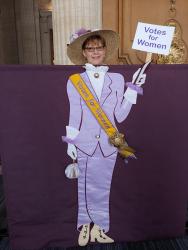
The history of the League of Women Voters stretches back nearly 100 years. Since then, its members have achieved several groundbreaking milestones. Click on the red links below to learn more (or here for a more detailed account of the formation of the LWVUS).
- Big Enough to See an Opportunity
- Educating All of the Electorate
- Early Legislative Achievements
- Progress in the Postwar Period
In her address to the National American Woman Suffrage Association's (NAWSA's) 50th convention in St. Louis, Missouri, President Carrie Chapman Catt proposed the creation of a "league of women voters to finish the fight and aid in the reconstruction of the nation." Women Voters was formed within the NAWSA, composed of the organizations in the states where suffrage had already been attained. The next year, on February 14, 1920--six months before the 19th amendment to the Constitution was ratified--the League of Women Voters was formally organized in Chicago as the national League of Women Voters. Catt described the purpose of the new organization:
"The League of Women Voters is not to dissolve any present organization but to unite all existing organizations of women who believe in its principles. It is not to lure women from partisanship but to combine them in an effort for legislation which will protect coming movements, which we cannot even foretell, from suffering the untoward conditions, which have hindered for so long the coming of equal suffrage. Are the women of the United States big enough to see their opportunity?"
Maud Wood Park became the first national president of the League and thus the first League leader to rise to a significant challenge. She had steered the women's suffrage amendment through Congress in the last two years before ratification and liked nothing better than legislative work. From the very beginning, however, it was apparent that the legislative goals of the League were not exclusively focused on women's issues and that citizen education aimed at all of the electorate was in order.
Since its inception, the League has helped millions of women and men become informed participants in government. In fact, the first League convention featured votes on 69 separate items as statements of principle and recommendations for legislation. They addressed a range of issues, inclduding protections for women and children, rights of working women, food supply and demand, social hygiene, the legal status of women, and American citizenship.
The League's first major national legislative success was the passage of the Sheppard-Towner Act, which provided federal aid for maternal and childcare programs. In the 1930s, League members worked successfully for enactment of the Social Security Act and Food and Drug Act. Due at least in part to League efforts, legislation passed in 1938 and 1940 that removed hundreds of federal jobs from the spoils system and placed them under civil service.
During the postwar period, the League helped lead the effort to establish the United Nations (UN) and to ensure U.S. participation in it. The League was one of the first organizations in the country officially recognized by the UN as a non-governmental organization; it still maintains official observer status today.